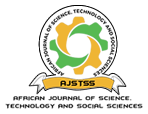Evaluation of antimicrobial susceptibility of escherichia coli isolated from contaminated areas of Majengo slum in Meru County, Kenya
DOI:
https://doi.org/10.58506/ajstss.v1i1.82Keywords:
E.coli, Susceptibility Testing, Antimicrobial Resistance, Majengo Slum, Multidrug Resistance, Ciprofloxacin, Ceftazidime, Cefotaxime, Imepenem, CefoxitinAbstract
Background: Antimicrobial drug resistance is of great concern today. Infections by the antimicrobial resistant strains of Escherichia coli, including enteropathogenic as well as enterotoxigenic strains have been reported as major causes of deaths especially among young children in low- and middle-income countries. This has been augmented by antimicrobial misuse, over the counter availability, lack of adherence to physicians’ instructions, drug misuse in animal industry, and Poor sanitation especially in informal settlements. This has majorly resulted to organisms changing the genetic make up to survive within different environments. Such microorganisms are distributed everywhere within environments posing great risk to children, adults as well as the aged, especially in informal settlements. Main objective: This study aimed at characterizing Antimicrobial Resistant Strains of Escherichia coli Isolated from Sanitation Environments of Majengo Slum in Meru County, Kenya Methods: A cross-sectional study was conducted on 61 samples from soil, water and drains swabs. These were tested against 5 antimicrobial drugs by Kirby disk diffusion method. The antimicrobial discs used included Imepenem (10μg); Ceftazidime (30μg); Cefotaxime (30μg); Cefoxitin (30μg) and Ciprofloxacin (5μg). Results: Forty-two (69%) of the samples had Escherichia coli. These recorded antimicrobial drug resistances were as follows: Cefoxitin 52.38%, Cefotaxime 42.86%, Ceftazidime 66.67%, Ciprofloxacin 61.90% and Imipenem 59.52%. Statistical analysis revealed a significance in comparison (Kruskal-Wallis tests) between the two strata. Statistic=19.87938408896494 (P 0.00052). Conclusion: This study showed that Escherichia coli isolated from Majengo is pathogenic and resistant to antibiotics. Detection of Escherichia coli pose a great risk in the spread of resistant strains in human. Recommendation: Proper sanitation and hygiene awareness practices should be provided through education to the residents of this area.


